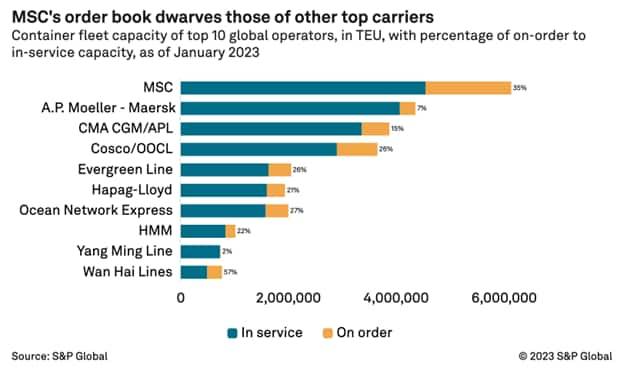2M breakup throws carriers’ operating playbook out the window
No one remotely familiar with container shipping, when they first saw the Jan. 25 announcement of the breakup of the 2M alliance, failed to recognize the thunderclap it represented for the industry and supply chains more broadly.
The immediate recognition of seismic significance echoed that of
the June 17, 2014 rejection by China of the proposed P3 alliance
among Maersk, Mediterranean Shipping Co., and CMA-CGM, a stunning
announcement at the time that confirmed China's global influence
and led directly to two of those carriers — Maersk and MSC
— joining up in the 2M for the past eight years.
This time, it wasn't just that the two largest carriers by deployed
capacity had decided to end their alliance in 2025 after 10 years,
a development many analysts greeted with minimal surprise given the
vastly different styles, cultures, and strategies of the two
entities.
Rather, in going their separate ways, it pulled back the curtain on
yet another industry era when concentration of market share among
the largest carriers had reached an inflection point, such that the
largest of them now have the ability to operate at scale outside of
a formal alliance. The potential impact on factors such as
long-term pricing can't be underestimated.
MSC did not say outright that it has no plans to re-join a formal
east-west alliance, only that its fleet provides it "with the scale
we need for the most comprehensive ocean and short-sea shipping
network in the market." Its fleet is already the world's largest
and will be further bolstered in the coming years after a spree of
new ordering and the largest secondhand tonnage acquisition spree
in shipping history, according to Alphaliner.
"Every move that the Swiss-Italian carrier made in the past two
years has apparently already been aligned with MSC's new
alliance-free strategy," Alphaliner said.
Maersk was clearer in disavowing alliances, with ocean product head
Johan Sigsgaard telling the Journal of Commerce, "we have come to
the conclusion that a more standalone Maersk network is a better
response to the coming years than it was in the past."
But irrespective of what actually happens in two years, the mere
possibility that Maersk or MSC could operate alone is a historic
change. Contrast this moment to an earlier era, when the industry
was far less consolidated and vessel-sharing agreements (VSAs) much
more limited in scope.
In that environment, carriers, unlike in the modern alliance era,
had little ability to blank sailings in the face of sagging demand,
as that could mean up to a two-week gap between sailings, which
even back then would have alienated customers. "Flexibility to
withdraw ships and services in response particularly to temporary
changes [in demand] is limited," then-APL CEO Flemming Jacobs said
in the first TPM opening keynote speech in 2001.
Alliances offer scale, agility
As VSAs and later full-fledged alliances evolved, the situation
changed: The scale and agility of the combined networks within the
2M, Ocean, and THE alliances evolved to the point where capacity
for the first time could be pulled on short notice without
catastrophic disruptions to service. That was nothing less than a
breakthrough for an industry that had suffered for decades with
inadequate returns on capital invested. Even in 2001, Jacobs made
reference to "the low return carriers receive for the capital
invested," a reality that persisted until the onset of
COVID-19.
Mass blanking of capacity was a turning point. It enabled the
industry to envision more stable and acceptable returns when prior
to that the only lever carriers had in their control to impact the
bottom line was cost reduction, often achieved through M&A
activity. Alliances allowed the carriers via their partners to
build extensive service networks, distribute and lower the costs of
deploying tonnage, increase utilization, and engage in capacity
management on a scale that had never been seen before. Maritime
analyst Linerlytica reported last week that services operated
within alliance arrangements enjoyed a 6 percent utilization
advantage over independent services.
The breakup of the 2M Alliance and the two largest carriers
potentially going it alone throws all of that into question.
It opens the door to a few possibilities. One is that the industry
— especially as it enters a potentially extended period of
overcapacity — reverts to a competitive scramble for market
share, driving down profits and forcing yet another round of
M&A, especially if regulators move against alliances. When MSC
has taken delivery of all the tonnage it has on order, it will be
30 to 35 percent larger than Maersk, capacity the company will
ensure does not go unutilized, according to several analysts. MSC
operating on its own "could lead to aggressive pricing," Jefferies
noted in a research note.
In that scenario, rate levels would return marginal profits to
ocean carriers while carriers would blank sailings when they are
forced to in order to stop bleeding cash.
"When there's over-capacity, freight rates will be roughly the cost
of providing the service. If the freight rates do not increase,
carriers will have to close down services and lay up vessels," said
Alan Murphy, CEO of Sea-Intelligence Maritime Analysis. That, in
turn, "should lead to freight rates increasing again."
Hardly a convincing recipe for an industry again in search of a
profitable formula.
Subscribe now or sign up for a
free trial to the Journal of
Commerce and gain access to breaking industry news, in-depth
analysis, and actionable data for container shipping and
international supply chain professionals.
This article was published by S&P Global Market Intelligence and not by S&P Global Ratings, which is a separately managed division of S&P Global.
